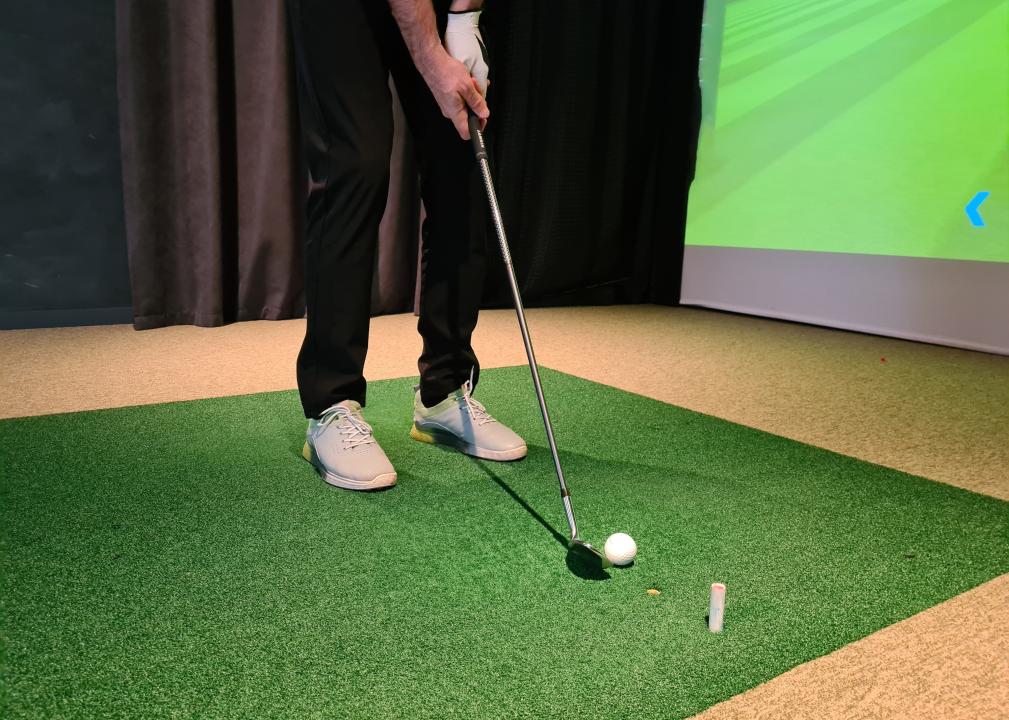Swinging success: The explosive growth of indoor golf
Justine Lynn Photo // Shutterstock
Swinging success: The explosive growth of indoor golf
Golf ball on tee at simulator.
It’s no secret that golf has earned a reputation as an elitist sport, synonymous with a certain higher social and economic status. The “gentleman’s game” is expensive to play with its costly equipment, apparel, and green fees. It is also a big time commitment, especially for those living in major cities where transportation and inflated prices can make playing a whole-day affair.
But over the last several years, the sport has become more accessible thanks to its versatility as an increasingly indoor activity. In the years since the COVID-19 pandemic, new golf simulator technology and companies have saturated the market, allowing golfers the chance to turn their homes and offices into personal driving ranges and enjoy virtual rounds of golf around the world in the comfort of their backyard, basement, or local watering hole.
According to the National Golf Foundation, about 6.2 million Americans hit golf balls using a simulator during the past year, a 73% increase compared to pre-pandemic levels, when simulator usage plateaued under 4 million. With successful franchises such as Five Iron and X-Golf continuing to expand (not to mention sprouting commercial indoor miniature golf companies, such as Swingers and Puttery) and cheaper options for home simulators, more and more players are golfing wherever it suits them best.
To further trace the sport’s recent evolution, PrimePutt mapped the rapid growth of indoor golf and its ramifications on the golf industry.
![]()
SergeyAbramov // Shutterstock
New technology is making indoor golf more affordable and accessible
A girl playing on a golf simulator.
There are numerous benefits to indoor golf, starting with accessibility. Instead of shelling out for clubs and competing for tee times (catering to a wealthier population of participants), not to mention the time-consuming hassle of getting to the course, golfers can book condensed swing sessions at local, often urban facilities for a potentially cheaper and easier option. The individualized setups provide instant swing feedback and metrics, allow for year-round play, and can be less intimidating for beginners (who might feel uncomfortable on a public course).
Why the sudden wave of interest in this activity? One of the biggest reasons is the evolving simulator and launch monitor technology. The competitive marketplace has lowered prices considerably, which have influenced many golfers to invest in their own off-course options. A basic setup with a golf swing monitor, mat, and net can now be purchased for around $1,000. In a consumer survey shared by the National Golf Foundation, 1 in 3 participants said they’ve used a simulator in a person’s home.
That growth has also led to a proliferation of indoor companies (there are now more than 1,600 businesses with a simulator) aiming to make golf a more approachable social activity by putting food, entertainment, and a gamifying spin on its stuffier stereotypes while still offering golf instruction and fittings to cater to more avid golfers. According to NGF, more than half of indoor golf customers don’t even play traditional greens, only highlighting the way the sport is trending toward more casual players.
“One of the main reasons people come to the Five Iron is because it’s peaceful and an oasis. It lends itself to an introvert who just wants a safe space and an urban environment,” Jared Solomon, CEO and co-founder of Five Iron, told Stacker. “But if you want to socialize and not pay a million dollars, it’s a pretty good place, too.”
NMK-Studio // Shutterstock
Indoor golf is advancing diversity in the game
Golf player playing golf indoors on golf simulator closeup.
In a recent report by agriculture company Syngenta and research firm Ipsos, which examined 16.1 million social media posts within the U.S. and the U.K. between 2019 and 2022, researchers found that golf is mostly talked about by white men and that the game’s lack of representation makes people of color feel less welcome. But with the recent growth of indoor golf as a more accessible and entertaining option, those stereotypes and stigmas are starting to change.
NGF research shows that in 2023, 32.9 million customers aged 6 years and older played off-course golf, up 18% from 2022, and echoes the demographic mix of the U.S. population “exhibiting a younger and more diverse representation (age, gender, race, and ethnicity) than the on-course population.” In addition, there are 23% more women and girls playing golf on a course since 2018, while the number of Asian, Black, and Hispanic golfers has increased substantially by 43%, no doubt fueled by the increased opportunities to try the game in cheaper and more accessible settings.
Meanwhile, of the 3 million-plus green grass golfers who have used simulators, their interest in the traditional game has only strengthened. Only 2% of indoor golfers said their simulated golf time cut into their time playing on an actual course, compared to 29% who said they play more, citing improvements in their own playing and equipment knowledge as reasons. An estimated 2.5 million golfers credit off-course golf experiences for getting them into the game.
But this is only the beginning. The golf simulator market is expected to reach $3.38 billion by the end of 2030, according to Straits Research. Solomon attributes most of that to one primary reason. “It feels really good when you hit a good ball,” he says. “I think the more people that get an opportunity to hit their first shot and get that shot euphoria, the more popular that the sport’s going to get.”
Story editing by Carren Jao. Additional editing by Kelly Glass. Copy editing by Tim Bruns.
This story originally appeared on PrimePutt and was produced and
distributed in partnership with Stacker Studio.


